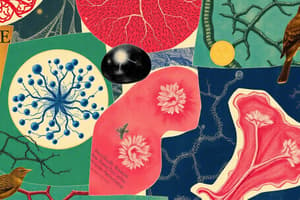Podcast
Questions and Answers
What is the function of the synapse?
What is the function of the synapse?
- Connecting the axon to the neuron
- Storing neurotransmitters
- Releasing neurotransmitters at the terminal
- Transmitting information between neurons (correct)
What is the main difference between a plant cell and an animal cell?
What is the main difference between a plant cell and an animal cell?
- Plant cells have a cell wall and chloroplasts, but animal cells do not. (correct)
- Plant cells are larger than animal cells.
- Plant cells have a nucleus, but animal cells do not.
- Plant cells are found in animals, but animal cells are found in plants.
The axon terminal stores neurotransmitters that release at the synapse.
The axon terminal stores neurotransmitters that release at the synapse.
True (A)
Eukaryotic cells have a nucleus and membrane-bound organelles.
Eukaryotic cells have a nucleus and membrane-bound organelles.
What is the term for the gap between the terminal of one neuron and the dendrite of another neuron?
What is the term for the gap between the terminal of one neuron and the dendrite of another neuron?
The ___________ of one neuron releases neurotransmitters into the synapse.
The ___________ of one neuron releases neurotransmitters into the synapse.
What is the smallest unit of organization in the hierarchy of life?
What is the smallest unit of organization in the hierarchy of life?
Tissues work together to form an ____________________.
Tissues work together to form an ____________________.
What is the role of neurotransmitters in the synapse?
What is the role of neurotransmitters in the synapse?
The synapse is a physical connection between two neurons.
The synapse is a physical connection between two neurons.
Match the following cell types with their characteristics:
Match the following cell types with their characteristics:
What is the level of organization that includes a group of organs working together?
What is the level of organization that includes a group of organs working together?
Match the following components of neural communication with their functions:
Match the following components of neural communication with their functions:
What is the term for the part of the neuron that stores and releases neurotransmitters?
What is the term for the part of the neuron that stores and releases neurotransmitters?
What is the primary function of the axon?
What is the primary function of the axon?
Myelin is produced by the axon.
Myelin is produced by the axon.
What is the role of the myelin sheath?
What is the role of the myelin sheath?
The _______________________________________ is responsible for transmitting information through electrical impulses.
The _______________________________________ is responsible for transmitting information through electrical impulses.
What is the result of the myelin sheath on electrical impulses?
What is the result of the myelin sheath on electrical impulses?
The axon is responsible for receiving signals from other neurons.
The axon is responsible for receiving signals from other neurons.
What is the function of electrical impulses in the nervous system?
What is the function of electrical impulses in the nervous system?
Match the following structures with their functions:
Match the following structures with their functions:
What are the two systems that control all body processes?
What are the two systems that control all body processes?
The endocrine system uses electrical impulses to send messages to the body.
The endocrine system uses electrical impulses to send messages to the body.
What is the primary function of the negative feedback loop?
What is the primary function of the negative feedback loop?
The endocrine system uses __________ to send messages to the body.
The endocrine system uses __________ to send messages to the body.
Match the following systems with their method of communication:
Match the following systems with their method of communication:
Which part of the brain is responsible for processing visual information?
Which part of the brain is responsible for processing visual information?
The cerebellum is responsible for regulating body temperature.
The cerebellum is responsible for regulating body temperature.
What is the function of the brainstem?
What is the function of the brainstem?
The _______________________ lobe is responsible for processing auditory information.
The _______________________ lobe is responsible for processing auditory information.
Match the following brain regions with their functions:
Match the following brain regions with their functions:
What is the function of the parietal lobe?
What is the function of the parietal lobe?
Flashcards are hidden until you start studying
Study Notes
Cell Types and Tissues
- Plant cells have a cell wall and chloroplasts, whereas animal cells do not have a cell wall or chloroplasts.
- There are two main types of cells: prokaryotic and eukaryotic.
- Prokaryotic cells have no nucleus and no membrane-bound organelles, whereas eukaryotic cells have a nucleus and membrane-bound organelles.
- Prokaryotic cells include bacteria and archaea, while eukaryotic cells include animals, fungi, and plants.
- The hierarchy of life goes from cells to tissues, organs, body systems, and populations.
Nervous System
- The nervous system and endocrine system control all body processes.
- The nervous system uses electrical impulses to send messages to the body, while the endocrine system uses hormones.
- The nervous system consists of:
- Axon: transmits electrical impulses.
- Myelin Sheath: allows electrical impulses to travel quickly and efficiently.
- Axon Terminal: stores neurotransmitters that release at the synapse.
- Synapse: connects neurons and transmits information from one neuron to another.
Homeostasis
- Negative feedback maintains homeostasis by increasing and then decreasing a signal to maintain a set point.
- Example: when body temperature is too high, the negative feedback loop reduces it to the set point.
Brain Structure
- The brain consists of:
- Temporal lobe
- Occipital lobe
- Frontal lobe
- Cerebellum
- Brainstem
- Parietal Lobe
- Each part of the brain has a specific function.
Studying That Suits You
Use AI to generate personalized quizzes and flashcards to suit your learning preferences.




